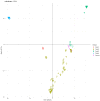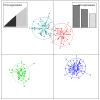Diversity of Water Yam (Dioscorea alata L.) Accessions from Côte d'Ivoire Based on SNP Markers and Agronomic Traits
- PMID: 34961033
- PMCID: PMC8705775
- DOI: 10.3390/plants10122562
Diversity of Water Yam (Dioscorea alata L.) Accessions from Côte d'Ivoire Based on SNP Markers and Agronomic Traits
Abstract
Dioscorea alata (L.), also referred to as water, winged, or greater yam, is one of the most economically important staple food crops in tropical and subtropical areas. In Côte d'Ivoire, it represents, along with other yam species, the largest food crop and significantly contributes to food security. However, studies focusing on better understanding the structure and extent of genetic diversity among D. alata accessions, using molecular and phenotypic traits, are limited. This study was, therefore, conducted to assess the pattern of genetic variability in a set of 188 D. alata accessions from the National Agronomic Research Centre (CNRA) genebank using 11,722 SNP markers (generated by the Diversity Arrays Technology) and nine agronomic traits. Phylogenetic analyses using hierarchical clustering, admixture, kinship, and Discriminant analysis of principal component (DAPC) all assigned the accessions into four main clusters. Genetic diversity assessment using molecular-based SNP markers showed a high proportion of polymorphic SNPs (87.81%). The analysis of molecular variance (AMOVA) showed low molecular variability within genetic groups. In addition, the agronomic traits evaluated for two years in field conditions showed a high heritability and high variability among D. alata accessions. This study provides insights into the genetic diversity among accessions in the CNRA genebank and opens an avenue for sustainable resource management and the identification of promising parental clones for water yam breeding programs in Côte d'Ivoire.
Keywords: DArT-seq; Dioscorea alata; agronomic trait; genetic diversity; molecular markers; population structure.
Conflict of interest statement
The authors declare no conflict of interest. The funders had no role in the design of the study; in the collection, analyses, or interpretation of data; in the writing of the manuscript, or in the decision to publish the results.
Figures





Similar articles
-
Phenotypic and molecular assessment of genetic structure and diversity in a panel of winged yam (Dioscorea alata) clones and cultivars.Sci Rep. 2019 Dec 3;9(1):18221. doi: 10.1038/s41598-019-54761-3. Sci Rep. 2019. PMID: 31796820 Free PMC article.
-
Exploring the genetic diversity and population structure of aerial yams (Dioscorea bulbifera L.) DArT-seq and agronomic traits.PLoS One. 2024 Aug 23;19(8):e0306631. doi: 10.1371/journal.pone.0306631. eCollection 2024. PLoS One. 2024. PMID: 39178185 Free PMC article.
-
Unravelling the genetic diversity of water yam (Dioscorea alata L.) accessions from Tanzania using simple sequence repeat (SSR) markers.PLoS One. 2023 May 31;18(5):e0286480. doi: 10.1371/journal.pone.0286480. eCollection 2023. PLoS One. 2023. PMID: 37256869 Free PMC article.
-
A Case of Need: Linking Traits to Genebank Accessions.Biopreserv Biobank. 2018 Oct;16(5):337-349. doi: 10.1089/bio.2018.0033. Biopreserv Biobank. 2018. PMID: 30325668 Free PMC article. Review.
-
Viruses of Yams (Dioscorea spp.): Current Gaps in Knowledge and Future Research Directions to Improve Disease Management.Viruses. 2022 Aug 26;14(9):1884. doi: 10.3390/v14091884. Viruses. 2022. PMID: 36146691 Free PMC article. Review.
Cited by
-
Extent and patterns of morphological and molecular genetic diversity and population structure of Nigerian Taro cultivars.BMC Plant Biol. 2024 Nov 14;24(1):1077. doi: 10.1186/s12870-024-05791-1. BMC Plant Biol. 2024. PMID: 39538118 Free PMC article.
-
Variability and genetic merits of white Guinea yam landraces in Nigeria.Front Plant Sci. 2023 Feb 6;14:1051840. doi: 10.3389/fpls.2023.1051840. eCollection 2023. Front Plant Sci. 2023. PMID: 36814760 Free PMC article.
-
Genetic diversity and population structure of soybean (Glycine max (L.) Merril) germplasm.PLoS One. 2025 May 8;20(5):e0312079. doi: 10.1371/journal.pone.0312079. eCollection 2025. PLoS One. 2025. PMID: 40341701 Free PMC article.
-
High Genetic Diversity and Structure of Colletotrichum gloeosporioides s.l. in the Archipelago of Lesser Antilles.J Fungi (Basel). 2023 May 27;9(6):619. doi: 10.3390/jof9060619. J Fungi (Basel). 2023. PMID: 37367555 Free PMC article.
References
-
- Adifon F.H., Yabi I., Vissoh P., Balogoun I., Dossou J., Saïdou A. Écologie, systèmes de culture et utilisations alimentaires des ignames en Afrique tropicale: Synthèse bibliographique. Cah. Agric. 2019;28:22. doi: 10.1051/cagri/2019022. - DOI
-
- Ano G., Gelabale J., Marival P. L’igname D. alata, la génétique et l’anthracnose en Guadeloupe, contribution de l’INRA: Passage de la collecte-introduction à la création de variétés résistantes. Phytoma Déf. Vég. 2005;584:36–39.
-
- Mignouna H.D., Abang M.M., Asiedu R. Chapter 23: Genomics of Yams, a Common Source of Food and Medicine in the Tropics. In: Moore P.H., Ming R., editors. Genomics of Tropical Crop Plants. Springer; Berlin, Germany: 2008. pp. 549–570.
-
- Alabi T.R., Adebola P.O., Asfaw A., De Koeyer D., Lopez-Montes A., Asiedu R. Spatial multivariate cluster analysis for defining target population of environments in West Africa for yam breeding. Intern. J. Appl. Geosp. Res. 2019;10:1–30. doi: 10.4018/IJAGR.2019070104. - DOI
Grants and funding
LinkOut - more resources
Full Text Sources

